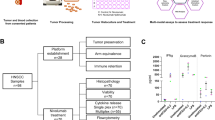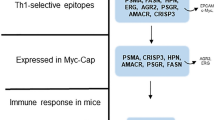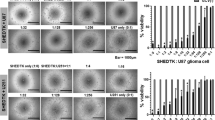Abstract
Treatment of hormone refractory prostate cancer requires new treatment strategies. Genetic prodrug activation therapy (GPAT) may provide a new therapeutic avenue. In this study the antitumour efficacy of the gene encoding herpes simplex virus thymidine kinase (HSVtk) activating the prodrug ganciclovir (GCV) was compared in two models of ectopic (subcutaneous) rat prostate cancer. Both models, which differ in their characteristics, were previously shown to be weakly immunogenic but susceptible to immunotherapy. Tumour cell lines were stably transfected with HSVtk and were rendered highly sensitive to GCV. Little or no bystander killing effect was observed by tk-transfected cells on wild-type cells in vitro. However, a significant in vivo bystander effect was observed suggesting an immune-mediated response. Indeed, such an immune response was capable of slowing the growth of distant wild-type tumours and increased overall animal survival. A T helper 1 immune response was generated as a result of GCV activation and cell kill, demonstrated by the secretion of IFNγ by cultured splenocytes in response to tumour cells. BrDU staining of tk-transfected cells treated with GCV in vitro suggested apoptotic cell death, but Annexin V staining was less marked for one of the cell lines. Serial in vivo monitoring by non-invasive magnetic resonance spectroscopy (MRS) of the tk-transfected MATLyLu tumours demonstrated a decreased ATP/Pi ratio (a measure of cell energy status) during growth and an increase in the ATP/Pi ratio during regression initiated by treatment with GCV. Further, significant differences were found in the phosphomonester (PME) to total phosphate (ΣP) ratios in treated compared with untreated tumours, a result rarely seen in animal models, but commonly observed in patients. This study showed that a Th1-biased immune response generated by killing prostate tumour cells with tk/GCV can kill distant as well as local wild-type tumour cells. These findings suggest that GPAT may have a potential application in patients with both confined and metastatic prostate cancer and MRS may provide a method of monitoring response to treatment.
This is a preview of subscription content, access via your institution
Access options
Subscribe to this journal
Receive 6 print issues and online access
$259.00 per year
only $43.17 per issue
Buy this article
- Purchase on SpringerLink
- Instant access to full article PDF
Prices may be subject to local taxes which are calculated during checkout








Similar content being viewed by others
References
Hrouda D, Perry M, Dalgleish AG . Gene therapy for prostate cancer Semin Oncol 1999 26: 455–471
Pardoll DM . Cancer vaccines Nat Med 1998 4: 525–531
Simons JW et al. Induction of immunity to prostate cancer antigens: results of a clinical trial of vaccination with irradiated autologous prostate tumor cells engineered to secrete granulocyte–macrophage colony-stimulating factor using ex vivo gene transfer Cancer Res 1999 59: 5160–5168
Tjoa BA et al. Follow-up evaluation of prostate cancer patients infused with autologous dendritic cells pulsed with PSMA peptides Prostate 1997 32: 272–278
Vesalainen S, Lipponen P, Talja M, Syrjanen K . Histological grade, perineural infiltration, tumour-infiltrating lymphocytes and apoptosis as determinants oflong-term prognosis in prostatic adenocarcinoma Eur J Cancer 1994 30A: 1797–1803
Hrouda D et al. Immunotherapy of advanced prostate cancer: a phase I/II trial using Mycobacterium vaccae (SRL172) Br J Urol 1998 82: 568–573
Maraveyas A et al. Possible improved survival of patients with stage IV AJCC melanoma receiving SRL 172 immunotherapy: correlation with induction of increased levels of intracellular interleukin-2 in peripheral blood lymphocytes Ann Oncol 1999 10: 817–824
Heriot AG et al. Reduction in cytokine production in colorectal cancer patients: association with stage and reversal by resection Br J Cancer 2000 82: 1009–1012
Blades RA et al. Loss of HLA class I expression in prostate cancer: implications for immunotherapy Urology 1995 46: 681–687
Freeman SM et al. The ‘bystander effect’: tumor regression when a fraction of the tumor mass is genetically modified Cancer Res 1993 53: 5274–5283
Vile RG et al. Systemic gene therapy of murine melanoma using tissue specific expression of the HSVtk gene involves an immune component Cancer Res 1994 54: 6228–6234
Ramesh R et al. In vivo analysis of the ‘bystander effect’: a cytokine cascade Exp Hematol 1996 24: 829–838
Alvarez RD, Curiel DT . A phase I study of recombinant adenovirus vector-mediated intraperitoneal delivery of herpes simplex virus thymidine kinase (HSV-TK) gene and intravenous ganciclovir for previously treated ovarian and extraovarian cancer patients Hum Gene Ther 1997 8: 597–613
Sterman DH et al. Adenovirus-mediated herpes simplex virus thymidine kinase/ganciclovir gene therapy in patients with localized malignancy: results of a phase I clinical trial in malignant mesothelioma Hum Gene Ther 1998 9: 1083–1092
Herman JR et al. In situ gene therapy for adenocarcinoma of the prostate: a phase I clinical trial Hum Gene Ther 1999 10: 1239–1249
Pettaway CA et al. Selection of highly metastatic variants of different human prostatic carcinomas using orthotopic implantation in nude mice Clin Cancer Res 1996 2: 1627–1636
Stubbs M, Griffiths JR . Monitoring cancer by magnetic resonance Br J Cancer 1999 80 (Suppl. 1): 86–94
Griffiths JR et al. 31P-NMR investigation of solid tumours in the living rat Biosci Reps 1981 1: 319–325
Griffiths JR et al. 31P-NMR studies of a human tumour in situ Lancet 1983 i: 1435–1436
deCertaines JD et al. In vivo 31P MRS of experimental tumours NMR Biomed 1993 6: 345–365
Ross BD, Kim B, Davidson B . Assessment of ganciclovir toxicity to experimental intracranial gliomas following recombinant adenoviral mediated transfer of the herpes simplex virus thymidine kinase gene by magnetic resonance imaging and proton magnetic resonance spectroscopy Clin Cancer Res 1995 1: 651–657.
Izquierdo M et al. Long term rat survival after malignant brain-tumor regression by retroviral gene-therapy Gene Therapy 1995 2: 66–69
Namba H et al. Evaluation of the bystander effect in experimental brain tumors bearing herpes simplex virus-thymidine kinase gene by serial magnetic resonance imaging Hum Gene Ther 1996 7: 1847–1852
Stegman LD, Ben-Yoseph O, Freyer JP, Ross BD . In vivo 31P MRS evaluation of ganciclovir toxicity in C6 gliomas stably expressing the herpes simplex thymidine kinase gene NMR Biomed 1996 9: 364–368
Hakumäki JM et al. 1H MRS detects polyunsaturated fatty acid accumulation during gene therapy of glioma: implications for the in vivo detection of apoptosis Nat. Med 1999 5: 1323–1327
Melcher A et al. Tumor immunogenicity is determined by the mechanism of cell death via induction of heat shock protein expression Nat. Med 1998 4: 581–587
Hrouda D et al. Mycobacterium vaccae (SRL172): a potential immunological adjuvant evaluated in rat prostate cancer Br J Urol 1998 82: 870–876
Hrouda D et al. Allogeneic whole tumour cell vaccination in the rat model of prostate cancer Br J Urd 2000 86: 742–748
Vieweg J et al. Immunotherapy of prostate cancer in the Dunning rat model: use of cytokine gene modified tumor vaccines Cancer Res 1994 54: 1760–1765
Sanda MG et al. Demonstration of a rational strategy for human prostate cancer gene therapy J Urol 1994 151: 622–628
Eastham JA et al. Prostate cancer gene therapy: herpes simplex virus thymidine kinase gene transduction followed by ganciclovir in mouse and human prostate cancer models Hum Gene Ther 1996 7: 515–523
Vile RG et al. Generation of an anti-tumour immune response in a non-immunogenic tumour: HSVtk killing in vivo stimulates a mononuclear cell infiltrate and a Th1-like profile of intratumoural cytokine expression Int J Cancer 1997 71: 267–274
Vile RG, Diaz RM, Castleden S, Chong H . Targeted gene therapy for cancer: herpes simplex virus thymidine kinase gene-mediated cell killing leads to anti-tumour immunity that can be augmented by co-expression of cytokines in the tumour cells Biochem Soc Trans 1997 25: 717–722
Steen RG et al. 31P NMR spectroscopic and near infrared spectrophotometric studies of effects of anesthetics on in vivo RIF-1 tumors. Relationship to tumor radiosensitivity NMR Biomed 1989 2: 87–92
Rodriguez LM et al. 31P nuclear magnetic resonance spectroscopy studies of the response of rat mammary tumours to endocrine therapy Cancer Res 1988 48: 89–93
Negendank WG . Studies on human tumours by MRS: a review NMR Biomed 1992 5: 303–324
Ruiz-Cabello J, Cohen JS . Phospholipid metabolites as indicators of cancer cell function NMR Biomed 1992 5: 226–233
Ordidge RJ, Connelly A, Lohman JAB . Image-selected in vivo spectroscopy (ISIS). A new technique for spatially selective NMR spectroscopy J Magn Reson 1986 66: 283–294
van der Veen JWC, de Beer R, Luyten PR, Van Ormondt D . Accurate quantification of in vivo P-31 NMR signals using the variable projection method and prior knowledge Magn Res Med 1988 6: 92–98
Acknowledgements
JD Eaton was supported by the Swire Group. MJA Perry was supported by the British Urological Foundation and Onyvax Ltd. RA Mazucco was supported by a grant from the Cancer Research Campaign UK (CRC) SP1971/0404. SM Todryk was supported by Onyvax Ltd. We are grateful to Dr R Vile (Mayo Clinic, Rochester, USA) for providing the HSVtk retroviral packaging line, and to Dr H Pandha and Dr M Stubbs (St George's Hospital Medical School) for very helpful discussion.
Author information
Authors and Affiliations
Rights and permissions
About this article
Cite this article
Eaton, J., Perry, M., Todryk, S. et al. Genetic prodrug activation therapy (GPAT) in two rat prostate models generates an immune bystander effect and can be monitored by magnetic resonance techniques. Gene Ther 8, 557–567 (2001). https://doi.org/10.1038/sj.gt.3301432
Received:
Accepted:
Published:
Issue date:
DOI: https://doi.org/10.1038/sj.gt.3301432
Keywords
This article is cited by
-
Effects of HSP90 inhibitor 17-allylamino-17-demethoxygeldanamycin (17-AAG) on NEU/HER2 overexpressing mammary tumours in MMTV-NEU-NT mice monitored by Magnetic Resonance Spectroscopy
BMC Research Notes (2012)
-
Immunotherapy of murine prostate cancer using whole tumor cells killed ex vivo by herpes simplex viral thymidine kinase/ganciclovir suicide gene therapy
Cancer Gene Therapy (2005)
-
Quantification and characterization of the bystander effect in prostate cancer cells following adenovirus-mediated FasL expression
Cancer Gene Therapy (2003)



